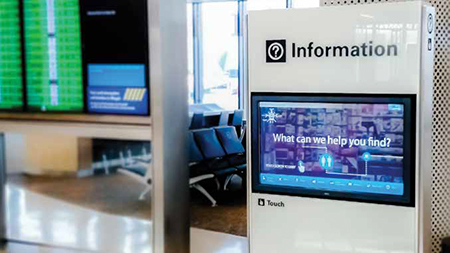An Interactive Message


Real-time stock information at the Toronto Stock Exchange with Omnivex signage. Think back to the first high-tech buzzwords you ever heard, and “interactive” very well may be on that list. But there’s a reason that this golden oldie remains a goodie, especially in AV: When it comes to digital signage, interactivity—technically defined as digital systems which respond to the user’s actions to present content—has its rewards.
In addition to the benefits that interactive digital signage presents to the clients and their visitors/users, it represents a prime opportunity for integrators. With new solutions continuing to rapidly multiply, refine, and converge, this sector allows AV pros to communicate with their clients on a deeper level.
“With the advances in interactive digital signage, integrators have the opportunity to be seen as more of a consultant than a box peddler,” said Eric Henry, vice president of signage solutions for Tightrope, based in St. Paul, MN. “It’s essential for integrators to go in, and interview customers to understand what their pain points are, and from there understand what their problem is that needs to be solved.
“Sometimes it’s not a problem, but an enhancement of the experience,” Henry continued. “The integrator needs to be seen as an expert who can make enhancements in the space. Then they can offer the direct services that are ultimately, from the integrator’s perspective, profitable. Too often what happens is that the integrator will move directly to a solution, and that feels too cookie-cutter, such as, ‘Hey, let’s throw in a wayfinder solution, or directory.’ But with research, they’ll find that something much more highly customized is what’s called for. So the integrator needs to really ask questions, and be able to interview.”

The Alma Rosa Winery & Vineyards tasting room features Planar’s Clarity Matrix LCD Video Wall. Doug Bannister, CEO of Concord, Ontario-based visual solution provider Omnivex, said he often compares a customer’s digital signage to its online presence. “We’ll ask, ‘What are your website’s purposes, requirements, and measures of success?’ The same is true of the digital signage system: right off the bat, you need to understand the requirements of the customer, and what success looks like. Are they just looking for content on screen? Many customers look for more than that. Is it a branding thing in a retail environment? Is it a kiosk? How is the screen mounted? Is there Wi-Fi? Is it in a marble lobby, with no way to put cables down? Are you interacting with LED lighting that changes? You have to think about the whole environment for an impactful presentation.”
Once the landscape has been thoroughly evaluated, integrators will find an escalating buffet of offerings to choose from. “Interactivity is a growing category on the whole,” observed Jennifer Davis, vice president of marketing for Planar Systems in Hillsboro, OR. “The most exciting examples I’ve seen recently involve great interface design—tapping into user experience expertise of the partner, software design that adds functionality, and a social/mobile element to tie in with other campaigns or initiatives beyond the one digital signage installation.

Omnivex installed its wayfinding interactive signage at San Francisco Airport (SFO) to help users navigate their terminal while waiting. “For instance, in the Seattle Space Needle, the content developer, a talented firm named Belle and Wissell, created a very compelling end-user experience on a multitouch video wall using Planar’s Clarity Matrix MultiTouch. As users approach the wall, they are presented with content in vertical stripes that can be moved up or down with a swipe of the hand. Then, when a visitor selects a picture or video, it plays in place where he or she touched, appealing to people of multiple heights, and providing great ADA access and easy engagement for children. As they scroll through content, visitors to the Seattle Space Needle are also invited to share their own images, in the form of a virtual guest book. This kind of two-way engagement, not only in the interface design of the installation, but in the content itself, is a growing trend.”
A daily selection of the top stories for AV integrators, resellers and consultants. Sign up below.
Speaking of buzzwords, “engagement” has its own place in interactive digital signage—and deservedly so. Clients and integrators need ways to weave social media into a signage experience that sticks. “Social media is a huge element of the marketing mix today and CMOs are looking to integrate those campaigns holistically into all their customer touch points,” Davis said. “From invitations to post content using hashtags, to the use of QR codes to link to experiences, to text-todonate features in museums, to branded apps interacting with signs in retail locations, the possibilities are endless.”

Jennifer Davis, vice president of marketing for Planar Systems. Meanwhile, big data—those complex data sets that can prove valuable when paired with the right predictive analytics—is also sought after to drive interactive digital signage. “Big data is always a part of it,” said Bannister. “We’ve all heard, ‘content is king,’ and content is important—it’s a visual medium—but content is not king. For example, if you take a great-looking piece of content designed to appeal to 18-year-olds, and show it to senior citizens, you miss the mark.
“So that’s why we say, ‘context is king.’ And how do you drive that? With big data. With inputs from everywhere—if it’s cold outside you show hot drinks, and if it’s raining, you show an umbrella. Our flagship product for those applications is Moxie, and it enables organizations to use their data to personalize content to an individual, location, or set of circumstances.”
So how can AV integrators make the leap, transitioning from pixel purveyors to being client advocates, content creators, and management service providers? “Step number one is to understand that over and above selling them equipment, that they are integrating digital media into the client’s environment,” said Denys Lavigne, senior director, experience strategy and creative services for Christie Digital. “It’s comprehending the notion of experience design, and how this new experience will bring value to the brand. How will this fit into the rest of the client’s marketing strategy, and bring value to the client.
“In today’s market, clients are expecting a deeper level of expertise and digital perspective from their technology provider—they expect them to deliver more of the solution, and also more guidance as to how the digital strategy comes together,” Lavigne added. “That’s why Christie got into digital strategy and content: To better support its network of integrators and enhance their capabilities to allow them to play a more significant role with their clients.”

Planar Clarity Matrix LCD Video Wall provides entertainment and an advertising platform in new multi-use office, retail and lodging complex. Throughout, integrators must balance ambition with an acceptance of their firm’s particular limitations. “What are the AV integrators good at? Do they have a content manager on their staff? Should they be hiring for that?” asked Omnivex’s Doug Bannister. “There’s a lot of revenue in these services, but obviously they need to do them well. Some AV integrators have that capacity, some don’t. If not, that’s not the end of the world—then partner with or resell the services of someone who does. Get great in some areas, and partner with others to round out the solution.”
And while content creation and management mastery is increasingly essential, soon even that might not be enough of an extension for an integrator—because the 360 awaits. “Another thing on a lot of clients’ minds is the notion of multiplatform, and how the experiences that we’re creating for a corporate lobby can find an extension on the web, or mobile app,” Christie’s Lavigne said. “That’s certainly something that’s in the mix, relaying these experiences to other platforms, repurposing and adapting them, and helping the client to make more mileage from their investment.”
Fittingly, a twist on a timehonored phrase points the way for AV integrators who are focused on interactive digital signage. “People talk about return on investment (ROI), but then there’s also return on objective,” said Eric Henry of Tightrope. “What is the client really trying to do, and will the solution we propose bring a return on objective? It all comes back to integrators being perceived as a consultant: They don’t have to know all the information, but the better questions that they ask, the better the results can be.”
David Weiss (www.dwords.com) writes extensively about AV, audio, and broadcast technology.
